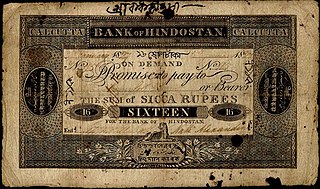The Chartered Bank of India, Australia and China was a bank incorporated in London in 1853 by Scotsman James Wilson, under a Royal Charter from Queen Victoria.
Modern banking in India originated in the mid of 18th century. Among the first banks were the Bank of Hindustan, which was established in 1770 and liquidated in 1829–32; and the General Bank of India, established in 1786 but failed in 1791.

The Bank of Calcutta was founded on 2 June 1806, mainly to fund General Wellesley's wars against Tipu Sultan and the Marathas. It was the first bank of India and was renamed Bank of Bengal on 2 January 1809.
Bangladesh is a developing country with an impoverished banking system, particularly in terms of the services and customer care provided by the government run banks. In recent times, private banks are trying to imitate the banking structure of the more developed countries, but this attempt is often foiled by inexpert or politically motivated government policies executed by the central bank of Bangladesh, Bangladesh Bank. The outcome is a banking system fostering corruption and illegal monetary activities/laundering etc. by the politically powerful and criminals, while at the same time making the attainment of services or the performance of international transactions difficult for the ordinary citizens, students studying abroad or through distance learning, general customers etc.

Citibank India is a foreign bank in India with a full service onshore platform. Its Indian headquarters is at Bandra Kurla Complex, Mumbai, Maharashtra. It is a subsidiary of Citigroup, a multinational financial services corporation headquartered in New York City, United States. Citibank India's services are investment banking, advisory and transaction services, capital markets, risk management, retail banking, and Cards. Although headquartered in Mumbai, the bank has most of its workforce based out of Chennai followed by Mumbai and Gurugram.

The Oriental Bank Corporation, or "OBC", was a British imperial bank founded in India in 1842 which grew to be prominent throughout the Far East. As an Exchange bank, the OBC was primarily concerned with the finance of trade and exchanges of different currencies. It was the first bank in Hong Kong and the first bank to issue banknotes in Hong Kong.
Matthew Atmore Sherring (1826–1880), usually cited as M.A. Sherring, was a Protestant missionary in British India who was also an Indologist and wrote a number of works related to India. He was educated at Coward College, a dissenting academy in London that trained people for nonconformist ministry.

Bank of Hindostan (1770–1832), a now defunct bank, is considered as among the first modern banks in Colonial India.

Thomas Frederick Lowry, better known as Fred Lowry, was an Australian bushranger.

John Foley was a bushranger and associate of Fred Lowry. In July 1863 they robbed several mail coaches, including the Mudgee mail robbery which netted £5,700 in bank-notes. Foley was captured several weeks later with bank-notes from the Mudgee mail in his possession. He was tried at Bathurst and sentenced to fifteen-years hard labour. Foley was released in 1873; he settled in the Black Springs district near Oberon and led a respectable life until his death in 1891.
The Agra Bank was founded in 1833 in Agra in the Indian state of Uttar Pradesh with a capital of £1,000,000.
Rajkissore Dutt was a 19th-century Indian businessman, who is most notable for perpetrating a major fraud against the Bank of Bengal, which is one of the predecessors of the State Bank of India.
The General Bank of India was a bank founded in the 18th century and lasted till 1791.
The General Bank of Bengal and Bihar was a bank founded in the year 1773 in British India. The bank was the third oldest bank in India. The bank became defunct March 31st, 1775.
The Bengal Bank was a bank founded in the year 1784 in British India. The bank was the fourth oldest bank in India.
The Union Bank was a bank founded in the year 1828 in British India by Prince Dwarkanath Tagore. The bank was the eleventh oldest bank in India.
The Commercial Bank was a bank founded in the year 1819 in British India. The bank was the eighth oldest bank in India.
The Calcutta Bank was a bank founded in the year 1824 in British India. The bank was the ninth oldest bank in India.
The The Government Savings Bank (1833) was a bank founded in the year 1833 in British India. The bank was the twelfth oldest bank in India.





